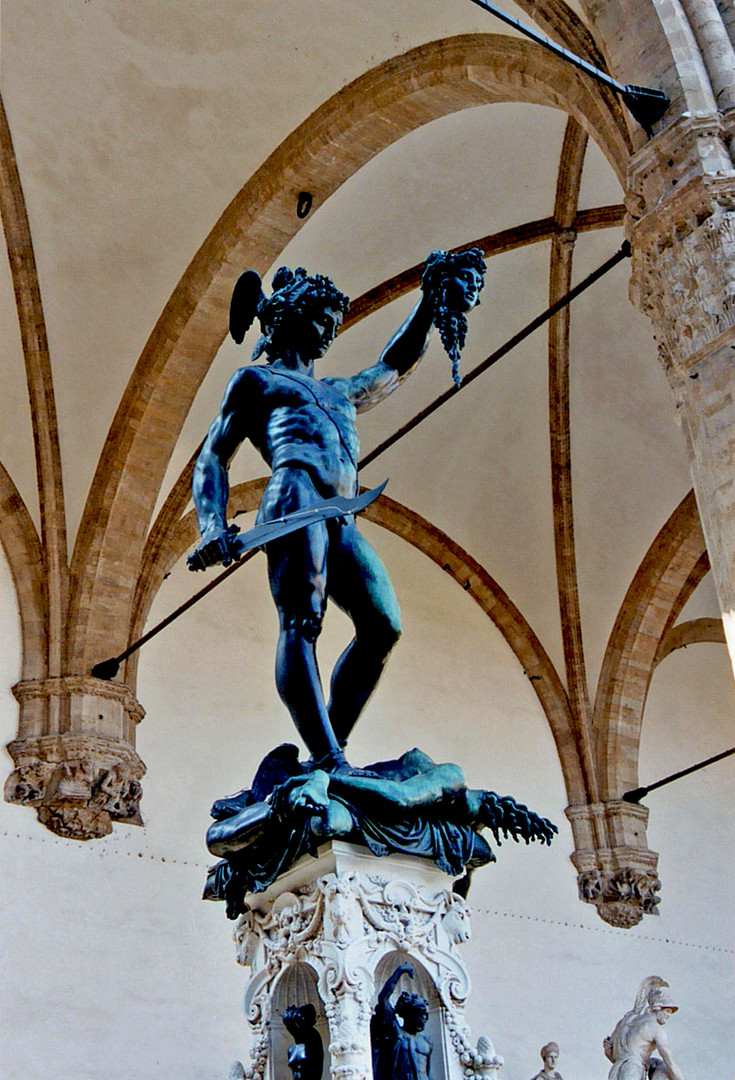Perseus With the Head of Medusa by Benvenuto Cellini, 1554, Loggia dei Lanzi, Florence
Perseus With the Head of Medusa by Benvenuto Cellini, 1554, Loggia dei Lanzi, Florence
Perseus With The Head of Medusa by Benvenuto Cellini stands in the Loggia dei Lanzi, where it has been nearly continuously since its completion around 1554. The statue was removed for cleaning and restoration in the late nineties, and perhaps is was moved (or sandbagged) during WW II. While there is a constant conversation in Florentine and Italian art and preservation circles about eventually moving this sculpture indoors and replacing it with a copy, at this point the original is in place, although the marble base with small bronzes is a replica (the original base is in the Bargello Museum).
The subject matter of the work is the mythological story of Perseus beheading Medusa, a hideous woman-faced Gorgon whose hair was turned to snakes and anyone that looked at her was turned to stone. Perseus stands naked except for a sash and winged sandals, triumphant on top of the body of Medusa with her snakey head in his raised hand. The body of Medusa spews blood from her severed neck. The bronze sculpture and Medusa’s head turns men to stone and is appropriately surrounded by three huge marble statues of men: Hercules, David and later Neptune. It is a truly remarkable bronze casting and Cellini mentions in his autobiography the troubles he had making it (Cellini was better known as a goldsmith and his bust is displayed on the Ponte Vecchio to celebrate this fact). The rear of Perseus' helmet is allegedly a self portrait of the artist.
Cellini was the first to integrate narrative relief into the sculpture of the piazza. As the Perseus was installed in the Loggia, it dominated the dimensions of later pedestals of other sculptural works within the Loggia, like Giambologna’s The Rape of the Sabine. Perseus added to the cast of Olympian gods protecting the Medici. Weil-Garris also focuses on the pedestal beneath the sculpture in the round. However, it may not have been Cellini’s original intent, as the relief was still being worked on and installed when the bronze sculpture above had already been revealed. The Medici still dominated the theme of the pedestal as Perseus in the pedestal acts as an allegory to Duke Francesco Medici.
In terms of the actual sculpture, bronze had not been used in almost half a century for a monumental work of art. Cellini made the conscious decision to work in this medium because pouring molten metal into his cast, he was vivifying the sculpture with life-giving blood. The most difficult part would be completing the entire cast all at once. Donatello’s Judith and Holofernes was already placed within the Loggia dei Lanzi in the westernmost arch. While it was made out of bronze, Judith was cast in several sections. Cellini was competing against monumental works, like Michelangelo’s David and wanted to make a statement for himself and the patron, Cosimo I. Michael Cole specifically draws attention to the process of casting the Perseus. Citing Cellini’s Vita, Cole notes how Cellini’s assistants let the metal clot and had Cellini not been present the work would have been destroyed. Cole then asserts that Cellini goes beyond reviving the work, but raised the dead, in which he means that Cellini’s salvation was remelting the bronze. Cellini also invokes Christ and by doing so he breathes life into the sculpture. Casting the Perseus was more than meeting the demand of Cosimo I; Cellini was proving himself to Florence in a newly refurbished medium. Serpents emerge from Medusa’s body, representing the people’s many past conflicts that had only worked to threaten and obstruct true democracy. Making the statue proved extremely difficult for Cellini, who truly put his talents to the test. He often spoke of his difficulty with Perseus in his autobiography. He complained about the difficulty fusing the statue in his kiln, and how he used all of the dishware in his home to make it. It is believed that Cellini used a young lover as his model for the statue, and on the back of Perseus’ neck, there is the small portrait of a bearded man, which many maintain is Cellini himself.
http://en.wikipedia.org/wiki/Perseus_with_the_Head_of_Medusa










Comentarios 0
Borrar comentario
Borrar comentario y respuestas